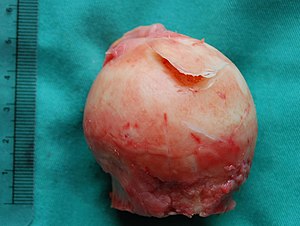Avascular necrosis of the hip
| Avascular necrosis | |
|---|---|
| Synonyms | Osteonecrosis, bone infarction, aseptic necrosis, ischemic bone necrosis |
 |
|
| Head of the femur showing a flap of cartilage due to avascular necrosis (osteochondritis dissecans). Specimen removed during total hip replacement surgery. | |
| Specialty | Orthopedics |
| Symptoms | Joint pain, decreased ability to move |
| Complications | Osteoarthritis |
| Usual onset | Gradual |
| Risk factors | Bone fractures, joint dislocations, alcoholism, high dose steroids |
| Diagnostic method | Medical imaging, biopsy |
| Similar conditions | Osteopetrosis, rheumatoid arthritis, Legg-Calve-Perthes syndrome, sickle cell disease |
| Treatment | Medication, not walking on the affected leg, stretching, surgery |
| Frequency | ~15,000 per year (US) |
| Classification |
· ·
|
|---|---|
| External resources |
Avascular necrosis (AVN), also called osteonecrosis or bone infarction, is death of bone tissue due to interruption of the blood supply. Early on there may be no symptoms. Gradually joint pain may develop which may limit the ability to move. Complication may include collapse of the bone or nearby joint surface.
Risk factors include bone fractures, joint dislocations, alcoholism, and the use of high dose steroids. The condition may also occur without any clear reason. The most commonly affected bone is the femur. Other relatively common sites include the upper arm bone, knee, shoulder, and ankle. Diagnosis is typically by medical imaging such as X-ray, CT scan, or MRI. Rarely biopsy may be used.
Treatments may include medication, not walking on the affected leg, stretching, and surgery. Most of the time surgery is eventually required and may include core decompression, osteotomy, bone grafts, or joint replacement. About 15,000 cases occur per year in the United States. People 30 to 50 years old are most commonly affected. Males are more commonly affected than females.
In many cases there is pain and discomfort in a joint which increases over time. While it can affect any bone, about half of cases show multiple sites of damage. Avascular necrosis primarily affects the joints at the shoulder, knee, and hip. The classical sites are: head of femur, neck of talus and waist of the scaphoid.
...
Wikipedia
